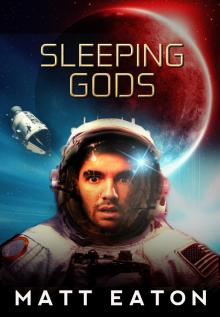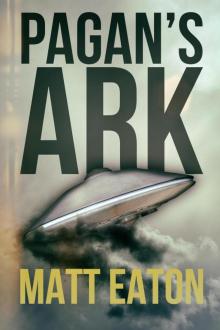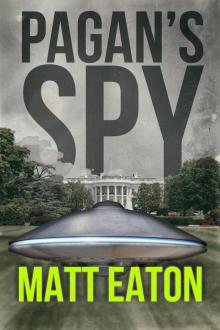- Home
- Matt Eaton
Sleeping Gods
Sleeping Gods Read online
GET MY NOVEL NOW FOR FREE
Many believe the Earth has fallen victim to a terrible act of God. To China and America, it’s a declaration of war. Each blames the other for what’s transpired. The oceans are 5m higher since the tsunamis retreated. Most survivors have lost their minds. They’re not insane — they're Blank. Empty vessels. Yet when special forces soldier Stone Luckman rescues Mel Palace from a collapsing high rise, she tells him she’s been expecting him for weeks. Crazy right? Together they might just be mad enough to reset the global compass and stop East and West from destroying each other.
Join my reader mailing list now and I’ll send
you a copy of my acclaimed novel, Blank, for free.
Click here for more:
https://mattjeaton.com/blank-free-download/
Sleeping Gods
Matt Eaton
Copyright
Copyright © 2016 by Matt Eaton
mattjeaton.com
Cover design by Fleur Camacho
Ebook formatting by Jesse Gordon, adarnedgoodbook.com
TABLE OF CONTENTS
Copyright
Beginning
Middle
End
The Apollo 8 spacecraft streaked manfully through the heavens at a mile per second, picking up speed rapidly as it approached the Moon. Astronauts Frank Borman, Jim Lovell and Bill Anders could feel no sense of speed nor acceleration but they knew their velocity would soon be a problem if they didn’t do something to slow down.
Their Command/Service Module was about 5000 nautical miles from the lunar surface and already under the Moon’s gravitational influence. They were unaware of its proximity because for some time they had not been able to see it through the window. They were heading into orbit backwards and awaiting the final calculations from Mission Control for firing the main SPS rocket. In Houston, the greatest minds in American space flight had been crunching numbers on the lunar orbit insertion, or LOI. Astronaut Jerry Carr was taking his turn at the capsule communicator console and called on the crew of Apollo 8 to check the maths.
“Apollo 8, Houston; with a preliminary LOI-1 PAD. Over.”
Lovell answered. “Roger. Stand by one.”
“Roger. Standing by,” capcom confirmed.
There was a long pause while Lovell readied himself to take the numbers. There would be no going at it half-cocked.
“Houston, Apollo 8. Ready to copy.”
“Apollo 8, this is Houston. Roger. LOI-1 SPS/G&N 62844, minus 1 point 61, plus 1 point 29, 069:08:19.05. Copy?”
“Eight is copying,” Lovell answered.
The numbers kept coming in a long line. Every digit needed to be right for the astronauts to execute a precisely synchronised rendezvous with the Moon, which itself was travelling through space at more than 3000 feet per second.
Houston had Apollo 8 lighting the candle at flight time 69 hours, eight minutes and 19 seconds. The burn had to last for precisely four minutes and two seconds. If the engine didn’t fire, their trajectory would become their fail-safe mechanism, bringing the spacecraft close enough to allow the Moon’s gravity to sling-shot them around and back toward Earth. If the burn was too long (meaning they couldn’t shut the engine down) the rapid loss of velocity would send them crashing into the Moon. If the engine cut out too soon and couldn’t be restarted, their command module would enter an elliptical orbit that would gradually decay under the counter influence of the Earth’s gravitational field and eventually catapult them into outer space.
“Apollo 8 this is Houston. At 68:04 you’re go for LOI.”
“OK, Apollo 8 is go,” said Borman.
“You’re riding the best bird we can find,” said capcom.
An hour later they said their farewells as they approached the far side of the Moon for the first time. Their velocity had increased to about 1.5 miles per second and was continuing to build rapidly. Strong emotions arose within each of the men in the capsule as they approached LOS … loss of signal.
“Thanks a lot troops, we’ll see you on the other side,” Anders told Mission Control.
Much to Commander Borman’s amazement, the Earth disappeared from view at precisely the moment stated in their mission schedule.
They were all alone. So far so good. Borman gazed briefly out of the window into the blackness. Back home it would soon be Christmas Eve.
NASA had given them the greatest Christmas gift ever — a trip to the Moon. They were right alongside it now, but for the moment the lunar night rendered the surface almost invisible. He strained for a sign of the lunar horizon - the sunset terminator - hoping to cross-check the ship’s attitude.
“On that horizon, boy, I can’t see squat out there,” said Borman.
“You want us to turn off your lights to check it?” Anders asked.
Lovell saw it first. “Hey, I got the Moon.”
“Do you?” asked Anders.
“Right below us.”
“Oh my God!”
The response alarmed Borman. “What’s wrong?”
“Look at that!” Anders called in astonishment. He was just admiring the view.
Borman was still nervous. “Well, come on – let’s – what’s, what’s the...”
“69.06,” Lovell replied, knowing LOI ignition time remained Borman’s primary concern.
“Stand by, we’re all set,” Borman replied. “2:13, 2:12...”
Just over two minutes to LOI.
But moments later Anders and Lovell were at it again, unable to restrain themselves from gazing out the window like space tourists. Borman had to marvel that years of training and simulation had utterly failed to prepare them for the toe-curling awe of the real thing. For all of human history it had been but a thumbnail smudge in the sky - and boy oh boy look at it now. But he didn’t want to think about it just yet. There was too much to do before they could relax.
“All right, all right, come on. You’re going to look at that for a long time,” he told them.
A handful of seconds later they fired the engine to start the longest four minutes of their lives.
“Everything’s good over here so far,” Borman called.
“Everything is looking good,” Anders confirmed.
In the stress of the moment it felt like time was slowing down. They were performing a task requiring a high degree of accuracy using equipment that had never before been put to the test so far from Earth. Catastrophic system failure was always a distinct possibility and halfway through the burn the tension was palpable.
“Y’know, it seems like about three gees,” Anders remarked.
A problem emerged about three minutes in. Apollo’s onboard computer told them thrust was two percent below optimal. They would have to burn a little longer to compensate, but it would be OK.
Finally Borman heard himself call out: “Shutdown”.
They successfully shut down the SPS and Apollo 8 was in an elliptical lunar orbit that took them as close as 60 nautical miles above the surface.
From Earth, the Moon was a crescent in the sky. This meant most of the far side (forever invisible from humanity) was illuminated in sunlight. It was an important consideration for the astronauts when they disappeared from the Earth’s view. They wouldn’t be in the dark for long.
From here on, their focus could shift to the one thing everyone was dying to take a close look at. Borman set the ship to rotate at precisely the right pace to keep the windows permanently pointed at the lunar surface. This created a strange effect. Because they were weightless, the notion of up and down had become almost meaningless. Their minds naturally adopted the interior of the capsule as the only frame of reference. That meant they felt as if they were alongside the Moon rather than above it.
Anders and Lovell began to set up the H
asselblad cameras to record what they saw. The surface wasn’t completely foreign – it had been photographed by a Russian satellite and NASA had acquired the imagery from the signal transmitted by the commie Lunar Orbiter. Seeing it for real beat the hell out of a few hazy satellite images. And back on Earth their photographs would offer far higher resolution for the boffins to examine in detail.
Although Bormann had faith and confidence in both NASA and the brilliant minds who had designed and built their spacecraft, it was nevertheless a great relief the first time they saw the Earth come back into view.
The familiar voice of Jerry Carr filled their headsets.
“Apollo 8, Houston. Over.”
The slightly uncertain lilt in old Jerry’s tone gave little away to the casual listener but it told Borman capcom had been getting a tad anxious. No doubt he had been calling them for some time without a response. Lovell put him out of his misery. “Go ahead, Houston. This is Apollo 8. Burn complete. Our orbit is 169.1 by 60.5.”
“Apollo 8, this is Houston. Roger. 169.1 by 60.5.”
As the astronauts passed over the Moon’s more familiar face they began to search for places where future Apollo missions might land. There were plenty of options. The Sea of Tranquillity was a strong possibility. Its gentle undulation looked positively inviting compared to the messed-up havoc of the far side. The face of the Moon forever pointed toward outer space almost felt like its hidden shame; craters upon craters, much more densely packed than they were on the near side. It was the result of a far greater frequency of impact from the relentless hailstorm of ice and rock from the asteroid belt and beyond battering its surface. The Moon’s near side was protected because it permanently faced the Earth due to the gravitational interaction known as tidal locking.
For Lovell and Anders, the job of photographing the Moon’s surface was proving tricky, owing to a fog of condensation that had built up on the main windows. This only left them with two small rendezvous windows, which had never been intended for photography.
Setting up the cameras and performing further spacecraft manoeuvres (including a second brief LOI burn to set them at an orbit with a low altitude of 70 miles) consumed much of their first three lunar orbits. They were on the fourth lap when they noticed Earthrise for the first time. It was breathtaking. Frantically, they snapped images of a lonely and fragile blue planet against a screen of dark infinity.
Borman was exhausted and knew he was going to have to rest. He decided to nap for two orbits. The others were too excited. They kept on working. Anders began taking a series of stereo photographs of the surface. Borman woke occasionally to speak to the others about how they were progressing. He began to realise his crew were making mistakes. They’d been awake 18 straight hours and were so tired they were no longer hearing each other properly. In a few more hours they’d have to perform a TEI – the trans-Earth injection rocket burn to escape the Moon’s orbit and begin their journey home. There was no way Borman could risk having a punch-drunk crew for that. He scrubbed all further scheduled experiments and ordered them to get some rest.
For the next two orbits, as they moved in and out of sleep, Borman found moments on the far side when he felt utterly alone in the universe. He snatched some time to gaze out the window, hopeful now for a glimpse of something they’d been warned they might see — something they’d agreed not to mention aloud because their every word was being recorded on the ship’s data storage equipment.
Shortly after LOS on orbit seven, the main window began to defog. The cameras were still rolling through the rendezvous windows, which meant they wouldn’t record what he now saw. They were still in lunar night. Yet beyond all reason and explanation he saw it, no mistake – a blinding light beaming up at him from the surface.
When Lovell and Anders awoke, he flicked them a pre-arranged hand gesture to indicate he’d had contact. It was all he had time for. They were on their eighth orbit, and the world was waiting. Shortly after regaining contact with Mission Control, Borman conducted a Christmas TV broadcast – ending it some 22 minutes later with a Bible reading by all three astronauts.
The reading was Borman’s idea. As a committed man of faith, he’d wanted to say something that would stay with people for a very long time. Bill Anders started the ball rolling. “We are now approaching lunar sunrise, and for all the people back on Earth, the crew of Apollo 8 has a message that we would like to send to you...
“In the beginning, God created the Heaven and the Earth. And the Earth was without form and void, and darkness was upon the face of the deep. And the spirit of God moved upon the face of the waters, and God said, ‘Let there be light.’ And there was light. And God saw the light, that it was good, and God divided the light from the darkness.”
Lovell took over. “And God called the light Day, and the darkness he called Night. And the evening and the morning were the first day. And God said, ‘Let there be a firmament in the midst of the waters. And let it divide the waters from the waters.’ And God made the firmament and divided the waters which were under the firmament from the waters which were above the firmament. And it was so. And God called the firmament Heaven. And the evening and the morning were the second day.”
Borman closed it out. “And God said, ‘Let the waters under the Heavens be gathered together into one place. And let the dry land appear.’ And it was so. And God called the dry land Earth. And the gathering together of the waters called the seas. And God saw that it was good. And from the crew of Apollo 8, we close with good night, good luck, a Merry Christmas and God bless all of you - all of you on the good Earth.”
It was a fine way to sign off, an offer of praise and wonder from three spacemen. He hoped everyone hearing them back home would take the message to heart.
For the astronauts themselves, however, the best was yet to come. Shortly after LOS on their final transit across the far side they crowded around the window.
There it was again, piercing the darkness. Except this time it began to grow brighter.
Quickly, Borman fumbled with a pocket on his spacesuit and pulled out a small leather case. He snapped it open and extracted a palm-sized Minox camera. Feeling more like Maxwell Smart than James Bond, he began snapping away at what they were seeing.
The Minox wasn’t the best camera for the job, but it was the only option for working outside the flight plan. This was a part of their mission NASA knew nothing about. Air Force intelligence had seen fit to explain it only to the Apollo program astronauts, and even then only in individual briefings. They had been sworn to secrecy as the information was highly classified, and because they were military men they did as they were told. They were ordered never to talk about it to anyone, not even to each other. This had resulted in some very stilted conversations in their final moments alone together back on Earth – just enough to confirm they were all in on the conspiracy.
The light rapidly began to grow larger and larger, which indicated it was moving at incredible speed away from the Moon and straight toward them. It stopped just a few metres away from their spacecraft, at which point the command module experienced a short, sharp jolt. The astronauts exchanged alarmed glances, but remained silent.
A saucer-shaped light the size of a house was stationary alongside Apollo 8, matching their speed and trajectory perfectly. It was way too close for comfort, but Borman didn’t have time to worry. A few seconds later the object shot off into space. He stared down for a moment at the tiny camera in his hands, knowing he would never see the photographs he had just taken. He shoved the Minox back in its case and zipped it into his pocket. No time to reflect. They had to prepare for the TEI.
About half an hour later, as Houston reacquired telemetry, the spacecraft’s signal confirmed the trans-Earth injection burn had been a success. At 89 hours and 34 minutes into the mission, astronaut Ken Mattingly was capcom in Houston, trying to re-establish radio contact.
“Apollo 8, Houston.”
“Houston, Apollo 8, over,” Lovell resp
onded.
“Hello Apollo 8, loud and clear,” chirped Mattingly.
“Roger. Please be informed there is a Santa Claus,” Lovell informed his fellow astronaut.
“That’s affirmative,” Mattingly answered. “You’re the best ones to know.”

 Sleeping Gods
Sleeping Gods Pagan's Ark
Pagan's Ark Pagan's Spy
Pagan's Spy Blank Extra Chapter
Blank Extra Chapter